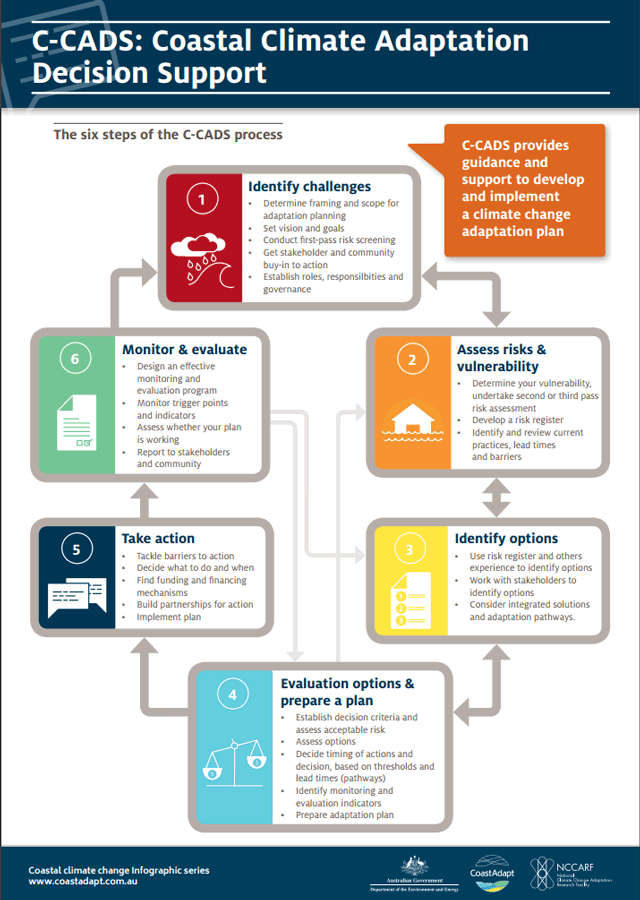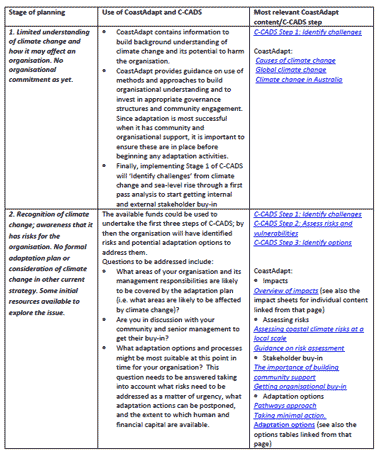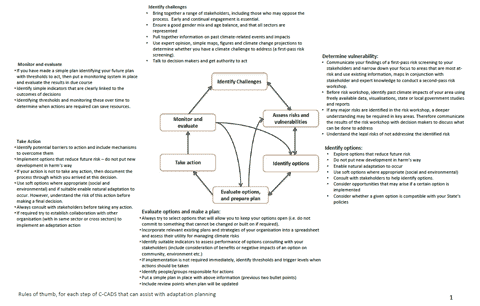You are here
The adaptation process
Coastal Climate Adaptation Decision Support (C-CADS)
Using C-CADS
C-CADS is an iterative decision support process designed to support adaptation planning and decision-making about all climate change related risks on the Australian coast. It is consistent with coastal zone management and adaptation planning approaches used by Australian states and territories.
- A key component of adaptation planning is to clarify your objectives, and understand the way in which climate change is likely to affect you, your organisation and its stakeholders.
- A key component of adaptation planning is to clarify your objectives, and understand the way in which climate change is likely to affect you, your organisation and its stakeholders.
- A key component of adaptation planning is to clarify your objectives, and understand the way in which climate change is likely to affect you, your organisation and its stakeholders.
Using C-CADS
Track Progress: Learn what is included in each step by expanding each C-CADS section (see left). Track your progress by clicking on the buttons.
Guidance: C-CADS provides detailed guidance, information and opportunities to learn more (scan, follow the steps, or delve deeper in priority areas). Click on the links in the figure above to access more information in each step.
Keeping Records: Adaptation planning and implementation can take time, and record keeping is essential. Use the template to record what has been done, when and by whom, and to attach copies of information and reports.
Using C-CADS: Get more detail about the use and application of C-CADS in this section by reading on.
At a glance
- C-CADS is an iterative decision support process that provides guidance on adaptation planning and implementation, and on developing and delivering specific adaptation projects. Users can work through a series of steps; from identifying climate change challenges and impacts through to implementing adaptation solutions, monitoring and evaluating their effects, and making necessary adjustments.
- C-CADS supports users to identify and overcome potential barriers to adaptation by getting organisational buy-in, communicating and engaging effectively with stakeholders and understanding financing options. It is designed to help users develop adaptation plans and actions that are fit for purpose in their context. Its iterative design—so users can move between sections depending on their planning stage and experience— enables users to build their personal and organisational capacity as they develop their plan.
- Use C-CADS by first scanning all steps to get a good overview. (The C-CADS infographic provides a useful overview of the process). Then follow steps in detail to develop and implement an Adaptation Plan. Delve into greater detail to support action in high-risk, priority areas.
- CoastAdapt provides more detailed guidance documents and case studies to help to contextualise some of the complex issues of adaptation such as planning under uncertainty.
- Importantly, C-CADS is consistent with risk-based coastal zone management and adaptation approaches used in Australia and internationally.
Main text
Introduction
C-CADS (see Figure 1) is a risk-based framework which is consistent with global best practice and the Australian Standard of Risk Management (AS/NZS ISO31000:2009) and more importantly, is consistent with current guidance on coastal zone management in Australian States and Territories. C-CADS is an iterative framework, designed to lead users from understanding their risk and vulnerability to climate change to taking effective action to address those risks. Because of its adaptive nature, C-CADS enables users to learn as they go, to try novel approaches, and deal with the challenges of uncertainty and constant change.
Why use C-CADS?
C-CADS has the advantage of an iterative design that helps users to address uncertainties of adaptation decision making by keeping options open and reducing unnecessary expenditure and the risk of being locked into actions that may not be the best or the most cost effective solutions to a long-term problem.
C-CADS recognises that there are a number of adaptation options, and that the best response may be to consider a combination of options delivered in a sequential manner in response to observed or projected changes to the effects of climate change. It provides detailed guidance to support users to identify thresholds and associated monitoring activities that can facilitate action.
C-CADS has been developed with a range of users in mind and so offers a flexible approach no matter what your experience level of adaptation planning. Users can start C-CADS at step one, or more experienced planners can skip through to a later, relevant step or use the framework to check and augment their existing efforts. It can be used to assess past approaches, to evaluate existing plans, to identify gaps, or to determine whether the planning process has been appropriate for addressing climate change.
C-CADS components
The six steps in C-CADS provide links to information in CoastAdapt on guidance, technical details about important aspects of adaptation and the coast, tools, worked examples, and case studies that illustrate adaptation in practice (see Figure 1).
Figure 1: The six steps of the C-CADS process and some of the key components within each step. Each box represents individual steps in the framework; each arrow indicates the relationship and navigation between steps. While it is important to monitor and evaluate your approaches throughout the planning cycle and make associated changes, there are also loops by which users can respond to the measured performance of their plan as well as to measures of trigger levels for action. Source: © NCCARF 2016.
Using C-CADs
Your use of C-CADS should depend on your needs, experience, the amount of prior adaptation knowledge, and your stage in the adaptation journey. You should consider the following points in determining how to use C-CADS to best suit your needs:
- The context: This includes prior knowledge and experience of climate change and adaptation in the organisation, including what has already been done. For example, has an adaptation strategy already been written? In a local council, does planning policy already seek to limit development in coastal locations exposed to risks from sea-level rise? Are there any actions or processes that your jurisdiction requires you to undertake?
- The goal of the exercise: What are you trying to achieve? Is this a first foray into adaptation, with a goal of simply understanding the risks and whether in the short-term action is necessary? Or are the risks known and so the goal is to identify and implement action?
- Available resources: What are the resources available (both human and financial capital)?
- Evaluation of risk: A rapid first-pass risk assessment (see Guidance on risk assessment) can be performed to evaluate the level of risk.
Is this a coastal council with soft shores that are prone to erosion and dense high-value coastal development? In this case, a full and costed evaluation of adaptation options is likely to be required, together with an implementation plan. All steps in C-CADS may need to be followed.
Or is it an urban council with a rocky shoreline? In this case, it may be possible to undertake only the first two steps of C-CADS to pinpoint the risks and make an evaluation of timing – for instance, when is it likely that sea level rise will create risks that require action to maintain ecosystem services and human well-being and safety?
Important to keep in mind:
Engagement and consultation should be done throughout your adaptation journey. Read the Information Manual 9: Community engagement for more information.
Learn from what you do. Set clear objectives for each activity you undertake and assess whether you have achieved these effectively. If not, make changes. Read more in the M&E guidance.
Table 1 provides four case studies of situations where C-CADS could be used, together with suggested links into CoastAdapt where further information can be obtained to support the adaptation process.
Table 1: How C-CADS could be used at four stages of organisational adaptation planning.
Start broad and then focus in: Before you follow any of the steps in C-CADS in any detail, you should first become familiar with the fundamental aspects of the whole of the C-CADS approach by scanning through the entire process. This is important because having an understanding of all the steps, processes and requirements will provide context for the various pieces of information.
When using C-CADS for the first time, you should scan through the full cycle, doing fairly rudimentary assessments and planning; particularly if you consider that you face relatively minor climate change-related risks. This enables you to consider existing information and plans to see if they fulfil some of the steps recommended in C-CADS. If then you identify the need to do more detailed risk assessments, you will need to delve deeper into all the components of C-CADS—investing more time and resources—to address your climate challenges. Similarly, if you determine there is considerable risk in some areas, you will need to seek out greater detail and more sophisticated approaches to support your response.
Table 2 provides further detail about the three levels of detail recommended for applying C-CADS. In all cases users need to be aware of the following steps in the entire planning cycle and should consider these before taking a more detailed approach.
Table 2: Three levels of the climate challenge, the types of users, and the approach for using C-CADS to support their adaptation response.
|
Climate challenge |
Users |
Approach |
|
| SCAN |
Initial overview (scan): Determining challenge Developing high level response |
All |
Rapid Initial overview of cycle for familiarisation. First-pass risk assessment determines little climate-related risk. Initial response enabled through rapid use of C-CADS cycle. Possible to use C-CADS only with some additional information obtained from within CoastAdapt. |
| PLAN |
Second-pass risk assessment and associated responses for developing a climate adaptation strategy to address climate-related risks |
Most coastal councils Private sector and others which have determined a medium to high risk from climate in first pass assessment |
Detailed risk assessment and planning approach required by C-CADS. C-CADS followed rigorously, with additional information and detail obtained from supporting information within C-CADS. |
| DELVE DEEPER |
Serious and complex risks associated with climate change impacts in certain areas of an organisation’s responsibility. Detailed assessment and response required. |
Relatively few councils, utilities, private sector which have identified significant risk associated with climate change |
Detailed risk assessment required. Usually conducted by consultants with detailed modelling and high complexity of information. C-CADS guidance supports the process with additional information obtained from within CoastAdapt and from links to further resources. Additional information may be required from outside C-CADS. |
Although C-CADS is a cycle, in reality many things can take place at once. Being aware of the full C-CADS process, and the various steps and tasks that should be done, can help you to make the best of opportunities, understand where they fit and ensure that they support your needs.
Importantly, although the monitoring and evaluation step is nominally at the end of the cycle, there is a need for users to assess the effectiveness of all their work in adaptation planning. This ensures flexibility and helps to achieve outcomes. For example, communication and engagement should take place throughout the planning cycle. Knowing whether it is effective right from the outset can help to guide direction and approaches that will save time, money and effort later.
The iterative nature of C-CADS supports you to take actions and learn from your experiences, making appropriate changes and then trying again. The approach supports you to select actions for particular conditions and also to monitor various threshold indicators. Only when a threshold is reached, will this trigger the implementation of a different action (often more expensive or controversial). This staging of actions ensures that you do not use unnecessary resources or alarm your stakeholders without sufficient evidence.
What if you have limited resources?
The C-CADS process can be followed regardless of available budgets. Each section provides information about what is required for each step and advice on how to complete the step in a cost effective manner. Each section also provides layered information with three different levels of detail. Note that occasionally the potential risks make it essential to obtain additional resources to address the risks effectively. CoastAdapt provides guidance on building a business case, financing options, prioritising action and seeking community support. All are very important considerations. Figure 2 provides a series of ‘rules of thumbs’ for each step of C-CADS to support users with limited resources.
For more information, see Implications of taking no action and Taking minimal action. It is up to the user to determine where they are in their own journey, and whether they need to seek additional resources to address effectively climate related risks. CoastAdapt provides information on engaging and working with consultants.
Figure 2: Rules of thumb, for each step of C-CADS that can assist with adaptation planning.







